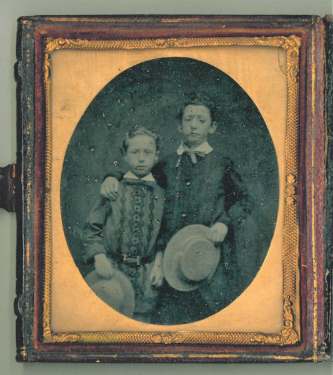Record Detail
| arc06209 | |
| Charles William Bragge (born 1850) with his brother George Stephenson Bragge (1853-1926), eldest sons of William Bragge (1823-1884) | |
| Sheffield | |
| 1851-1899 | |
This photograph is thought to show Charles William Bragge (born in Chester 1850) and George Stephenson Bragge (born in Rio de Janeiro, Brazil, 1853), the eldest sons of William Bragge (1823-1884). The photograph dates from a period when the Bragge family were living in Sheffield having relocated there from South America in August 1858. Note: A series of letters survives at Sheffield City Archives written by William Bragge's second son George Stephenson Bragge from Neuwied am Rhein, Germany, where he was sent (at the age of 16) to complete his schooling, back to his family in Sheffield, May 1870 - May 1872 (Ref. MD7801/3/3). George's education in Germany coincided with the outbreak of the Franco-Prussian War in July 1870 and his letters home provide some interesting insights into how the events of the war unfolded through the eyes of a teenager from Sheffield who was being educated in Germany at the time. William Bragge was a noted engineer and antiquary. Born in Birmingham in 1823, he went out to Brazil in 1852 and was responsible for overseeing the lighting the city of Rio de Janeiro with gas for the first time. He went on to supervise the construction of the first railway in Brazil (the line from Rio de Janeiro to Petropolis) before turning his attention to Argentina, where he lit Buenos Aires with gas for the first time and oversaw the construction of Argentina's first railway. He returned to England from South America in 1858 where he settled in Sheffield on the invitation of Sir John Brown (1816-1896) to become a partner (and later Managing Director) of John Brown and Company, Steel Manufacturers of Atlas Works. Outside of Bragge's role in Sheffield as Managing Director of Sir John Brown and Company, he played a prominent part in public life in Sheffield, becoming Master Cutler, Councillor and later Alderman, President of the Sheffield Literary and Philosophical Society, President of the Sheffield School of Art, Chairman of the Free Libraries and Museum Committee (where he played a key role in the establishment of Weston Park Museum). He was also a keen antiquarian who amassed extensive collections of rare manuscripts and artefacts, many of which were sourced from his extensive overseas travels. He continued to travel widely working for Sir John Brown and Company. Arguably Bragge's most remarkable antiquarian collection, was of pipes and smoking apparatus, sourced from all over the world. He published a catalogue on the collection which listed some 13,000 examples of pipes from places far and wide including China, Tibet, Japan, Van Diemen's Land, the Gold Coast North and South America, Greenland and the Falkland Islands. The collection also included hundreds of different samples of tobacco and snuff boxes, etc. The collection was ultimately broken up and dispersed. Bragge was the author of two catalogue works concerning tobacco: lsquo;Bibliotheca Nicotiana; a first catalogue of books about tobacco rsquo; (1874) and lsquo;Bibliotheca Nicotiana; a catalogue of books about tobacco together with a catalogue of objects connected with the use of tobacco in all its forms rsquo; (1880). Bragge lived in Sheffield between 1858 and 1877 (latterly having spells in Paris where he was engaged in a sewage purification treatment scheme). In Sheffield, Bragge lived initially at Collegiate Crescent before moving to Shirle Hill on Cherry Tree Hill Road (the former residence of Sir John Brown who had been instrumental in bringing Bragge to Sheffield in the first place). Bragge returned to his native Birmingham following his wife Martha's death at home at Shirle Hill in March 1877. Original at Sheffield City Archives: MD7801/5/4. |
Copying and access
This digital image, and all images on Picture Sheffield, are protected by copyright. You may use it for private study or non-commercial research, with due acknowledgement.
You may share it on social media via a linked post or by citing www.picturesheffield.com together with the Image Reference, unless its copyright is noted as belonging to another organisation. You must not reproduce it by any other means without permission.
